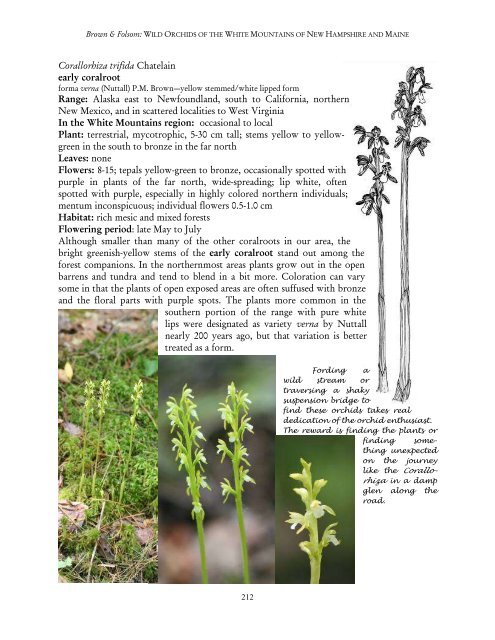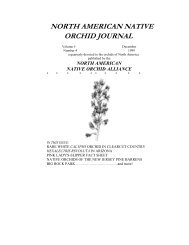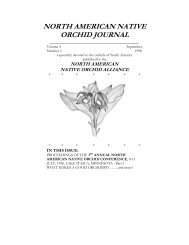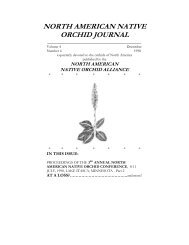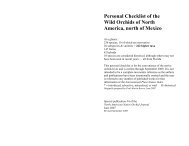north american native orchid journal - at The Culture Sheet
north american native orchid journal - at The Culture Sheet
north american native orchid journal - at The Culture Sheet
You also want an ePaper? Increase the reach of your titles
YUMPU automatically turns print PDFs into web optimized ePapers that Google loves.
Brown & Folsom: WILD ORCHIDS OF THE WHITE MOUNTAINS OF NEW HAMPSHIRE AND MAINE<br />
Corallorhiza trifida Ch<strong>at</strong>elain<br />
early coralroot<br />
forma verna (Nuttall) P.M. Brown—yellow stemmed/white lipped form<br />
Range: Alaska east to Newfoundland, south to California, <strong>north</strong>ern<br />
New Mexico, and in sc<strong>at</strong>tered localities to West Virginia<br />
In the White Mountains region: occasional to local<br />
Plant: terrestrial, mycotrophic, 5-30 cm tall; stems yellow to yellowgreen<br />
in the south to bronze in the far <strong>north</strong><br />
Leaves: none<br />
Flowers: 8-15; tepals yellow-green to bronze, occasionally spotted with<br />
purple in plants of the far <strong>north</strong>, wide-spreading; lip white, often<br />
spotted with purple, especially in highly colored <strong>north</strong>ern individuals;<br />
mentum inconspicuous; individual flowers 0.5-1.0 cm<br />
Habit<strong>at</strong>: rich mesic and mixed forests<br />
Flowering period: l<strong>at</strong>e May to July<br />
Although smaller than many of the other coralroots in our area, the<br />
bright greenish-yellow stems of the early coralroot stand out among the<br />
forest companions. In the <strong>north</strong>ernmost areas plants grow out in the open<br />
barrens and tundra and tend to blend in a bit more. Color<strong>at</strong>ion can vary<br />
some in th<strong>at</strong> the plants of open exposed areas are often suffused with bronze<br />
and the floral parts with purple spots. <strong>The</strong> plants more common in the<br />
southern portion of the range with pure white<br />
lips were design<strong>at</strong>ed as variety verna by Nuttall<br />
nearly 200 years ago, but th<strong>at</strong> vari<strong>at</strong>ion is better<br />
tre<strong>at</strong>ed as a form.<br />
212<br />
Fording a<br />
wild stream or<br />
traversing a shaky<br />
suspension bridge to<br />
find these <strong>orchid</strong>s takes real<br />
dedic<strong>at</strong>ion of the <strong>orchid</strong> enthusiast.<br />
<strong>The</strong> reward is finding the plants or<br />
finding something<br />
unexpected<br />
on the journey<br />
like the Corallorhiza<br />
in a damp<br />
glen along the<br />
road.


